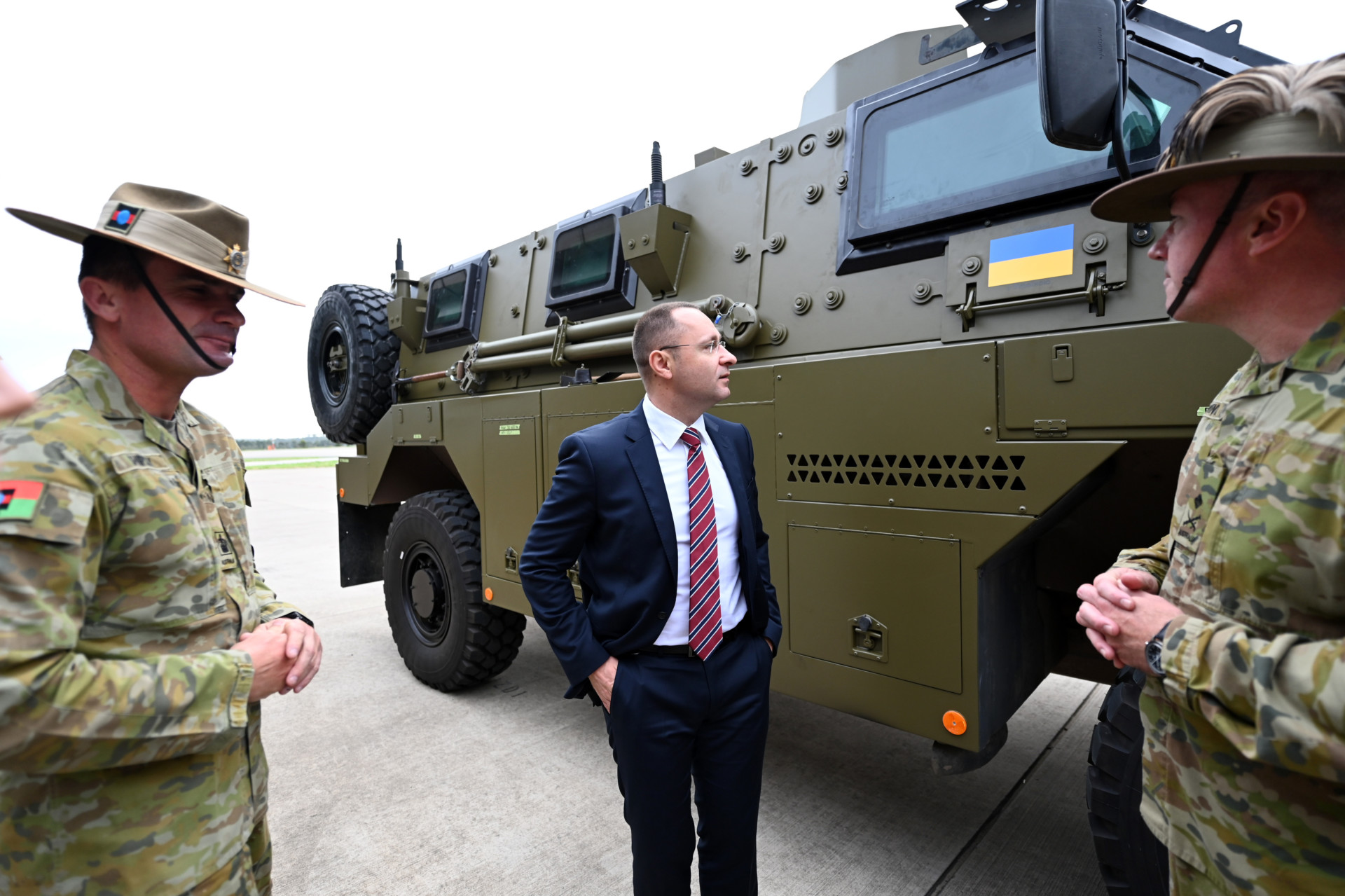By any objective assessment, the Russian invasion of Ukraine has not gone well. Comprehensively defeated in an attempt to seize the capital, Kyiv, President Vladimir Putin has since seemingly abandoned his maximalist aims of overthrowing the Zelenskyy government and installing a puppet government and has instead settled for “simply” attempting to annex the Donbas in the east of Ukraine.
While ultimate credit for defeating the initial phase of the Russian invasion must go to the Ukrainian people, there’s no question that Western military assistance has played a critical role in enabling them to do so as effectively as they have. The first stage of this assistance was largely confined to small arms and shoulder-launched weapons, which could be quickly supplied in large quantities as Western countries scrambled to respond to the invasion. Such weapon systems, most notably NLAW and Javelin anti-tank guided missiles and Stinger surface-to-air missiles, were crucial in allowing Ukraine to weather the initial Russian assault, but both the Ukrainian government and its Western allies have recognized that the country will need a continuing supply of heavy weaponry to enable the country to ultimately win the war. “The coming weeks will be so crucial for Ukraine”, warned U.S. Secretary of Defense Lloyd Austin during a support conference at Ramstein Air Base in Germany. “So we’ve got to move at the speed of war.”
As part of his continued pressure on Western countries to supply his country with the weapons they need, Ukrainian President Volodymyr Zelenskyy on April 13 launched his “Arm Ukraine Now” campaign, directly appealing to Western governments for specific types and amounts of heavy weapons that he says Ukraine needs to win the war. In typical style, Zelenskyy also asked for Western populations to put pressure on their governments to send these weapons and produced an accompanying website that listed what Ukraine needed, what had been promised, and what had been delivered.
New Lines conducted an independent investigation into what weapons systems have been pledged, what has been delivered, and what Ukraine still needs, based on international reporting. Only systems pledged by official sources or visually confirmed to have been delivered are included here.
Heavy Artillery
Multiple Launch Rocket Systems (MLRS) — stated need by Ukraine: 100 units.
DELIVERED: RM-70 (an upgraded Czechoslovak version of the BM-21 “Grad”) from Czechia, the exact number is unconfirmed but is reported to be “about 20,” according to the Wall Street Journal. Several of these vehicles were shown being transported via rail to Ukraine by independent monitor Ukraine Weapons Tracker.
DELIVERED: An unknown number of BM-21 “Grad” MLRS from Poland have also been delivered to Ukraine, as confirmed by Polish state radio in late April.
The “Grad” and similar systems are old and relatively unsophisticated – not too different from the famous “Stalin’s organ” Katyusha rocket launchers that terrified German soldiers during the Second World War – but the Ukrainians know how to use and maintain them, and they are still capable of saturating an area with fire in a short time. They are also relatively common in the arsenals of ex-Soviet NATO members.
Howitzers — stated need by Ukraine: 300 units.
DELIVERED: 18 M-777 155mm howitzers from the United States. Announced in the $800 million assistance package unveiled by the White House on April 13. A further 72 were promised in the second assistance package unveiled April 21. According to chief Pentagon spokesman John Kirby, “more than half” of the 90 howitzers pledged to Ukraine had arrived in the country by April 27.
The Australian government promised an additional 6 M777 howitzers on April 26, and Canada promised 4 M777s on April 22.
DELIVERED: 9 D-30 122mm howitzers from Estonia. These ex-Soviet weapons were delivered at the start of April, according to the Ukrainian Ministry of Defense.
Additional artillery is always useful, and the Ukrainians have been making exceptionally good use of their existing stocks of ex-Soviet pieces so far. Their new M777 guns have significantly longer range than the D-30 models both Ukraine and Russia commonly use and are incredibly accurate. Possibly more importantly, moving to the 155mm NATO standard will significantly simplify ongoing logistics for Ukraine’s Western allies – supplies of cheap, plentiful 155mm artillery shells will be effectively limitless from NATO stocks.
DELIVERED: ShKH vz. 77 DANA 152mm self-propelled howitzers from Czechia. An unknown number of these vehicles had been delivered by mid-April, and one was shown in action in footage posted by Ukraine Weapons Tracker.
An older but still effective system, the DANA’s high mobility allows for rapid repositioning after firing a salvo – a tactic known as “shooting and scooting” – which enables the system to avoid return fire.
DELIVERED: 2S1 Goździk 122 mm self-propelled howitzers from Poland. An unknown number of these vehicles were confirmed to have been delivered to Ukraine by Polish state media at the end of April.
A Polish-produced variant of the 2S1 Gvozdika, which Ukraine already operates in large numbers, these old but effective ex-Soviet self-propelled guns were able to enter Ukrainian service immediately, with no additional training or logistical support needed.
PROMISED: 5 Panzerhaubitze 2000 155mm self-propelled howitzers from the Netherlands. According to Dutch Prime Minister Mark Rutte, the ammunition for these systems will be provided by Germany and training for Ukrainian crews will be a Dutch-German joint operation. According to Die Welt, the German government has also been considering supplying an additional 7 systems from Bundeswehr stocks, but this transfer has yet to be finalized.
A significant pledge, the P2000 is one of the best self-propelled guns in the world. It is powerful, highly accurate, fast firing – it has the ability to “burst fire” three rounds in nine seconds – and has a very long range.
PROMISED: 12 CAESAR 155mm self-propelled howitzers from France. French President Emanuel Macron pledged the howitzers in an interview with Ouest-France.
Another highly capable modern weapon, taken directly from French Army stocks, the CAESAR saw action during the French intervention in Mali and was by all accounts very effective.
Artillery shells — stated need by Ukraine: 400,000 shells
PROMISED: $165 million worth of older ammunition from the United States. On April 25, the Pentagon announced a large purchase of ex-Soviet ammunition for Ukraine’s older, Soviet-origin weapon systems. This package includes BM-21 Grad rockets, 82mm mortar rounds, tank shells for T-72s and T-80s, and 152mm rounds for 2A65 Msta howitzers.
Despite the ongoing delivery of NATO standard heavy weapons, most of Ukraine’s weapons are still of Soviet or Russian origin. Keeping these guns firing by sourcing appropriate ammunition is therefore critical — a point not lost on the Russians who blew up two arms warehouses in the Czech city of Vrbětice and poisoned Bulgarian arms dealer Emilian Gebrev in an attempt to stop the supply of such munitions in the mid-2010s.
Heavy Armor
Tanks — stated need by Ukraine: 300 units.
DELIVERED: T-72M1/M1R from Poland. The exact number is unconfirmed but is “over 240,” according to Polish officials quoted in The Wall Street Journal. Prime Minister Mateusz Morawiecki had earlier confirmed delivery of the vehicles, which constitutes well over a third of the type in Polish service.
DELIVERED: “Dozens” of T-72M1 from Czechia, according to a Czech defense source cited in Reuters. Footage of the Czech tanks being shipped by rail to Ukraine was later uploaded to social media.
PROMISED: M-84A4 “Sniper” tanks from Slovenia. An upgraded Yugoslavian variant of the T-72, these vehicles are to be delivered to Ukraine in exchange for more modern replacement tanks supplied to the Slovenians by Germany. Slovenia currently has 19 operational M-84A4s and 32 in storage.
The T-72 is an old tank, and the variants provided to Ukraine are some of the oldest models. But they’ve still got a very powerful 125mm gun, and used properly they can still be very effective. While they can’t go toe to toe with the most modern Russian tanks, Ukraine’s plentiful supply of long-range antitank guided missiles means that they often won’t need to. Perhaps more importantly, the Ukrainians can operate or maintain them without any additional training, and they can quickly and cheaply “up armor” them by bolting on blocks of explosive reactive armor. And significantly, the impressive number of these vehicles donated to Ukraine means the country probably has more tanks in its arsenal now than it did at the start of the war.
Armored Vehicles — stated need by Ukraine: 600 units.
DELIVERED: A number of BWP-1 infantry fighting vehicles from Poland were seen being delivered alongside Polish T-72s in mid-April. The BWP-1 is a Polish version of the ubiquitous Soviet BMP-1 infantry fighting vehicle. Additionally, several BVP-1 infantry fighting vehicles – the Czech version of the same vehicle – were seen being delivered by rail in a report broadcast on Czech television.
PROMISED: 56 Pbv-501 from Czechia. Another lightly modified BMP-1 variant, these vehicles were originally East German before being exported to Sweden after the fall of the Berlin Wall. When withdrawn from Swedish service, they were exported once more to Czechia, where they sat in storage until the German government approved their delivery to Ukraine at the start of April.
Despite being arguably nearly obsolete, the BMP-1 can still be useful – an old armored vehicle is better than no armored vehicle – and like the older T-72s, it can be used for training, in second-line or territorial defense units, and to free up more modern infantry fighting vehicles for front-line units. These vehicles also are familiar to the Ukrainians and can be operated and maintained without any additional training.
DELIVERED: 20 Bushmaster infantry mobility vehicles from Australia began arriving mid-April, according to the Australian government. The Bushmaster is highly mobile and able to mount a variety of weapons, from automatic grenade launchers to heavy machine guns.
PROMISED: The assistance package unveiled by the White House on April 13 promised 200 M113 armored personnel carriers and 100 M1114 armored HMMWV infantry mobility vehicles. The April 21 assistance package promised 72 ”tactical vehicles’’ designed to tow artillery.
Also falling into the “old but still useful” category, these vehicles are lightly armored but can still fulfill a supporting role on the modern battlefield. Even when not suitable for front-line service, they’re still useful for training, second-line duties with the Territorial Defense, towing artillery, or ferrying ATGM (anti-tank guided missile) or MANPADS (man-portable air defense system) teams.
PROMISED: The United Kingdom pledged 120 armored personnel carriers. According to Armed Forces Minister James Heappey, 40 of these will be variants of the “Combat Vehicle Reconnaissance (Tracked)” platform, and 80 will be a mixture of Mastiff, Wolfhound, and Husky vehicles.
PROMISED: Canadian Defense Minister Anita Anand promised 8 Roshel Senator armored personnel carriers from Canada.
These vehicles differ in capability depending on the model in question. The wheeled Mastiff, Wolfhound, and Husky models are veterans of the British campaign in Afghanistan and as such are designed for crew survivability against roadside bombs and are quick on road. The tracked CVR(T) models, supplied variants of which will include the Spartan armored personnel carrier, the Samaritan armored ambulance, and the Samson armored recovery vehicle, offer superior offroad performance. The Roshel Senator is a lightly armored wheeled vehicle intended for law enforcement use – it will most likely be used by elements of the Ukrainian National Guard or Territorial Defense.
Long-Range Artillery Missiles/Tactical Missiles — stated need by Ukraine: 100 units.
None have been promised or delivered as yet. This is almost certainly due to Western fears that targets inside Russia – although unambiguously legal under the laws of armed conflict – would be attacked by Western-manufactured or supplied weapons, with the potential escalatory risk this engenders.
The counterargument to this concern is that targets inside Russia have been repeatedly struck by Turkish supplied Bayraktar TB-2 drones, with very little Russian response directed toward Ankara. The British and Americans have also been increasingly bullish about the Ukrainian right to strike targets inside Russia, with Heappey stating it was “not necessarily a problem” if Ukraine used U.K.-supplied weapons to strike inside Russia and Blinken stressing Ukraine’s right to “do whatever is necessary to defend against Russian aggression” in testimony to a congressional panel.
Anti-Ship-Missiles: — stated need by Ukraine: 300 units.
PROMISED: The United Kingdom promised to deliver “anti-ship missiles” in the first week of April. British Prime Minister Boris Johnson stated in Parliament that vehicle-mounted Brimstone Sea Spear missiles were being developed by the Ministry of Defense. On April 27, Heappey was quoted in The Times as saying “hundreds” of Sea Spear missiles would be provided in “the next few weeks.”
The need to provide anti-ship missiles is arguably not as crucial as it was in early April – the Ukrainians already have demonstrated the capability of their indigenous Neptune ASMs sinking the Moskva, the flagship of Russia’s Black Sea Fleet. However, stocks of these missiles are believed to be limited.
Air Defense Systems
Long-Range Surface-to-Air systems: — stated need by Ukraine: a ‘few dozen’ batteries.
DELIVERED: One battery of the S-300PMU air defense system and 45 missiles were delivered by Slovakia on April 8, with footage of the system being delivered to Ukraine via rail being published by the Slovakian government.
Long range, accurate, and extremely powerful, the S-300 is one of the most capable surface-to-air missile systems in the world. The Ukrainians need many more similar systems to effectively defend their airspace.
Short-Range Air Defense Systems — number needed not explicitly stated.
DELIVERED: A number of Strela-10 short range SAM systems from Czechia. According to Reuters, these systems were spotted on a train apparently bound for Ukraine.
The Strela-10 is old but still effective against the helicopter gunships that the Russians operate in large numbers. It can also be used against slower Russian fixed wing attack aircraft like the Su-25.
PROMISED: According to British Defense Secretary Ben Wallace, a “small number” of Stormer HVM carriers will be delivered to Ukraine. The Stormer mounts the Starstreak high-velocity missile on the CVR(T) chassis for extra mobility and crew protection. The targeting system is more sophisticated than the man-portable version as well.
Starstreak missiles are fast, extremely destructive, and immune to spoofing by Russian countermeasures. They can also be used to target lightly armored ground vehicles.
PROMISED: 50 Flakpanzer Gepard self-propelled anti-aircraft guns from Germany. Approved by Defense Minister Christine Lambrecht on April 25, the supply of these ex-Bundeswehr vehicles marks the first time Germany has directly supplied heavy weapons.
The Gepard itself is an older system, but the Russians are still flying many of the helicopters and attack aircraft it was originally designed to combat. Its twin autocannons can also effectively engage infantry and lightly armored vehicles.
Combat aircraft:— stated need by Ukraine: 50 units.
DELIVERED: Spare parts enabling 20 airframes to be returned to service. While whole airframes have yet to be delivered to Ukraine, a senior US defense official confirmed to CNN the Ukrainian Air Force has “added about 20 more operational aircraft to its fleet because of an influx of spare parts.”
Getting grounded Ukrainian airframes back into service is effectively a stopgap measure until the supply of additional aircraft can be arranged. Considering the war is probably going to continue for many more months and the Ukrainian Air Force will have to be rebuilt after the war anyway, Western countries should begin training Ukrainian pilots to fly NATO aircraft like the F-16.
Helicopters: — stated need by Ukraine: 50 units.
DELIVERED: The United States delivered 16 Mi-17 transport helicopters, originally procured for the Afghan government, as of April 27.
A workhorse in countless air forces across the world, the Mi-17s also are being used in a ground attack role by Ukraine. However, just as is the case for fixed-wing aircraft, the Ukrainians will undoubtedly need to be supplied with Western helicopters in order to rebuild their rotary capability after the war and would thus benefit from being trained on these aircraft now.
Light Vehicles
Pickups and/or trucks: — stated need by Ukraine: 2,000 units.
Many different types have been delivered by national governments, corporations, civil society organizations, and even individual donors. Examples have included armored civilian ambulances and ex-Foreign Office armored Land Cruisers from the British government, 100 Chevrolet Tahoe SUVs and Ford Ranger pickup trucks from General Motors and Ford, respectively, and a convoy of secondhand Polish four-wheel drive vehicles purchased by crowdfunding. It’s impossible to know how many in total have been supplied because of the ad hoc and slightly chaotic manner of such donations.
Zelenskyy has been an extremely effective advocate for his country in its time of greatest need. He called for Western powers to step up the supply of heavy weapons, and in many cases the West has answered that call.
Many of the deliveries of ex-Soviet heavy weaponry have been structured as a win-win for ex-Warsaw Pact NATO members: Not only are they supporting Ukraine, but their inventories are backfilled with the latest NATO weaponry in exchange.
While the Ukrainians seem to have the current Russian offensive in the Donbas contained, for the Ukrainians to win the war they’ll have to push Russian forces completely out of the country. Continuing and adaptive Western support will be crucial for this to happen. Fortunately for the Ukrainians, Western governments have now invested so much in Ukraine’s survival, both financially and politically, that such ongoing support is a virtual certainty.
The pertinent question, then, is what form mid- to long-term support of Ukraine will take. Moving to NATO standard calibers and adopting Western weapon systems will vastly simplify ongoing logistics, while adopting Western fighter aircraft will give Ukrainian pilots the chance to engage the Russian air force on even terms. Ultimately, this process will have succeeded if, after winning the war, the Ukrainian military is formidable enough to deter future Russian aggression.
James Rushton is an independent security and foreign policy analyst based in the U.K. He has a particular interest in British defense and foreign policy, as well as civilian protection in conflict zones.
The views expressed in this article are those of the author and not an official policy or position of the New Lines Institute.






